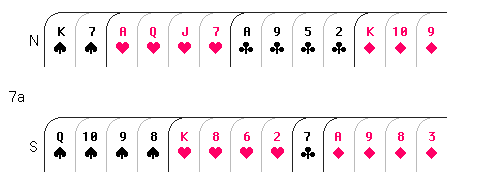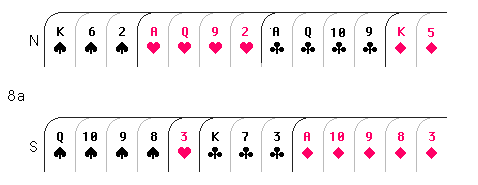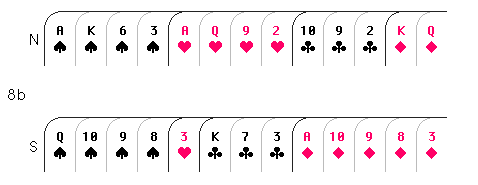(Down Fast - Up - Top)
BR 8.3 - The Stayman Convention (Bidding Guide p.12)
Say your Partner opens the bidding with 1NT, and you hold the following unbalanced hand. What is your response ?
- You have 9 points but being unbalanced should not respond with 2NT
- You have no 5 card suit and therefore should not respond with a suit bid either.

The solution to this problem is provided by the Stayman Convention
After an Opening bid of 1NT a Response of 2♣ is the Stayman Convention. It shows 8+ points, at least one 4 card major suit, and asks Opener to bid his 4 card major suit.
Opener's replies are :
- 2♦ - with no 4 card major
- 2♥ - with 4 Hearts (or 4 cards in both major suits)
- 2♠ - with 4 Spades
If there is a trump fit the Responder then raises the major suit to 3 (with 8-9 points) or to Game (with 10+ points).
If there is no trump fit the Responder bids 2NT with 8-9 pts, or 3NT with 10+ pts.

Here are two typical examples.
(Down - Up - Top)
Hand 7
Your Partner opened 1NT.
You are the Responder with Hand 7.

You have an unbalanced hand with 9 points and both 4 card majors. An ideal hand to bid Stayman : 2♣
(Down - Up - Top)
Case 7a
North opens with 1NT.

- South responds with Stayman 2♣
- North replies with 2♥ - showing a 4 card Heart suit.
- South, after revaluating his hand (12 pts including shortage pts) bids 4♥
(Down - Up - Top)
Case 7b
North opens with 1NT.

- South responds with Stayman 2♣
- North replies with 2♦ - showing no 4 card major suit.
- South, with 9 points now bids 2NT
- North, with 18 points bids 3NT
(Down - Up - Top)
Hand 8
Your Partner opened 1NT.
You are the Responder with Hand 8.

- Make a Stayman Response of 2♣.
This way you can explore the possibility of a trump fit in your 4 card Spade suit.
If Partner denies having 4 Spades you can still bid your 5 card Diamond suit, warning him that your hand is not balanced.
(Down - Up - Top)
Case 8a
North opens 1NT.

- South responds with Stayman 2♣.
- North replies 2♥ - showing a 4 card Heart suit.
- South now bids 3♦ - showing an unbalanced hand with 4 Spades (as he did not support Opener's Hearts) and 5 Diamonds.
- North, confident that he has South's short suits (Clubs and Hearts) covered now bids 3NT.
(Down - Up - Top)
Case 8b
North opens 1NT.

- South responds with Stayman 2♣.
- North replies 2♥ - showing a 4 card Heart suit. (With both 4 card majors he also must bid Hearts.)
- South now bids 3♦ - showing an unbalanced hand with 4 Spades and 5 Diamonds.
- North, realising that South's 4 card major must be Spades now confidently bids 4♠.
(Remember : South may only bid the Stayman Convention if he has at least one 4 card major. Otherwise there is no point in asking for 4 card major suits.)
Some general points :
- The Stayman Convention can also be used for semibalanced hands and even with balanced 4432 distributions which includes a weak doubleton.
- After a 2NT Opening - a 3♣ Response is also Stayman.
- If you use the Stayman 2♣ bid, the weak Rescue bids can only be made for Diamonds, Hearts and Spades !
(Down - Up - Top)
BR 8.4 - Signals by the Defence
When a Defender is not required to play a high card to a trick he can take that opportunity to send a signal to his Partner.
This happens especially on the opening lead.
For example in a 3NT contract Partner makes the opening lead with the Queen of Clubs. The lead is obviously the top of a solid sequence. Dummy plays low from three small cards in the suit and you hold
K 7 2
By playing the Club 7 in stead of the 2, an 'unnecessary high card', you encourage Partner to continue to lead that suit and signal to him that you hold an honour card (in this case the King) in the suit.
What is a high card ?
Usually 6 or higher, but it all depends on what you hold in your hand.
|
With K J 6 4 the 6 is a 'high card' and the 4 low. But with
K J 4 2
the 4 is the 'high card' and encourages. |
It is therefore important that Partner looks carefully at all the cards in his hand, in Dummy and on the table played in the trick.
Traditionally the high - low signal (high card on one trick, often followed by a low card on the next or a later trick) is ecouraging, the low - high signal discouraging or neutral.
In recent times several variations are popularly in use, such as encouraging indicated by low - high, or odds - evens.
I have included high - low signals in Deal 19 and
Deal 20 of this lesson.
Can you identify situations in Example Deals from earlier lessons where a high - low would be appropriate ? (Answer).
(Down - Up - Top)
BR 8.5 - Deals 17 to 20
Deals 17 to 20 are examples of bidding and play as outlined in this lesson.
BR 8.6 - Quiz 8
- Answers - Review
(Up - Top - Links page)
Copyright © 2006 Michael Furstner (Jazclass). All rights reserved.